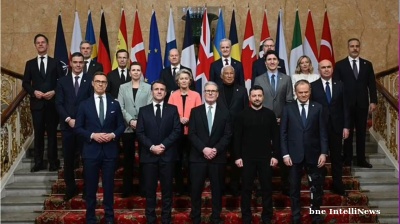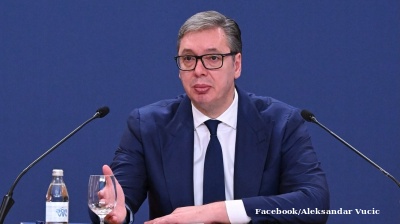The Trump administration’s sanctions on Russian oil giants Rosneft and Lukoil, announced on October 22, may appear decisive at first glance, but they are not going to make a material difference to Russia’s export of oil, Sergey Vakulenko, an independent energy analyst, said in a paper for Carnegie Endowment for International Peace on October 28.
The sanctions made headlines as they are the first imposed by Washington since Donald Trump returned to the White House, but in substance, they offer little that is new—and even less that is likely to change the Kremlin’s war policy, says Vakulenko.
“India and China are unlikely to stop buying Russian oil. Both countries see the Ukraine war as a conflict to which they are not a party, and they value Russia as a supplier of relatively inexpensive crude oil. They are also prepared to stand up for their sovereignty in the face of US pressure. It’s possible that large Chinese and Indian refineries will temporarily feign a willingness to give up Russian oil—but they will resume purchases when Trump’s attention wanders,” says Vakulenko.
The new restrictions on Rosneft and Lukoil are the same sanctions that were already applied to two more Russian oil majors, Surgutneftegas and Gazprom Neft, in January as part of the “toughest oil sanctions ever” by the outgoing Biden administration.
That earlier round of sanctions caused a brief spike in delivery costs to India and China and a dip in oil export volumes, but those effects quickly wore off. Russian oil exports continued, largely through shell companies or shadow fleets. The Kyiv School of Economics (KSE) has also noted that such workaround mechanisms usually take several months to find, but then the business returns to normal.
“Like the sanctions on Rosneft and Lukoil, Biden’s sanctions initially appeared to be a big deal. But they did not dent oil production or export volumes for either company. While overhead costs for the delivery of oil to China and India initially increased, they subsequently returned to pre-sanction levels,” says Vakulenko.
Rather than design new measures, the Trump administration could have simply enforced existing rules, such as the G7’s oil price cap. But this would have appeared as a continuation of Biden-era policy—something that is anathema to Trump. “These new sanctions serve more as a political message than an economic weapon,” says Vakulenko.
Indeed, they are unlikely to change Vladimir Putin’s strategic calculations. For the Russian president, the war is not a cost-benefit exercise. It is existential—“a point of principle,” Vakulenko notes. The symbolic value of continuing the war, even at mounting economic cost, is more important to Putin than any measurable loss in revenue.
Nor are Russia’s top energy buyers likely to walk away. India and China, which have maintained high volumes of discounted Russian crude imports, see the war as “a conflict to which they are not a party.” While Chinese and Indian refiners may briefly feign compliance, history suggests they will resume purchases as soon as Washington’s attention shifts.
“It’s possible this financial blow might push the Kremlin to spend a bit less on defence, which might help Ukraine. But it is not nearly enough for Putin to start thinking about changing course,” says Vakulenko.
Rosneft and Lukoil represent nearly 50% of Russia’s oil production. Together with Surgutneftegas and Gazprom Neft, now more than 80% of Russian liquid hydrocarbons are under US sanctions. Yet the Kremlin’s global footprint remains broad. Rosneft retains stakes in India’s Nayara Energy, Egypt’s Zohr gas field, and Germany’s Schwedt refinery—though the latter is now under Berlin’s control.
Lukoil, meanwhile, has active operations in Iraq, Uzbekistan, Congo, Mexico, Romania, and Bulgaria, along with upstream stakes in Kazakhstan and Azerbaijan.
Most foreign projects—excluding exempted ventures in Central Asia like Tengizchevroil and the Caspian Pipeline Consortium (CPC)—now face operational disruptions, dividend restrictions, and contractor risk. Germany has already requested a US exemption for Schwedt, which supplies 12% of Germany’s petrol and Berlin in particular, but the Biden-to-Trump transition has complicated transatlantic alignment. Washington may leverage the refinery’s legal limbo to push Berlin toward full nationalisation—an option fraught with political and legal challenges.
Between them, the two companies account for 4.4mbpd of Russian exports, about two thirds of Russia’s total exports and half its production. Removing that amount of oil from the market should have caused prices to spike, but the oil market’s response to the sanctions has been modest. Prices jumped $5 per barrel—a signal that traders do not foresee major disruptions. Vakulenko argues that if the US were serious about drastically cutting Russian oil exports, the spike would have been closer to $30.
Still, short-term export declines are likely. India may reduce purchases, aside from imports via Nayara, while China will likely maintain current volumes. This could result in a drop of around 700,000 barrels per day, or a 15% hit to Russia’s foreign currency earnings.
But these volumes are easily replaceable. With OPEC+ reversing production cuts, global supply is already outpacing demand and the International Energy Agency (IEA) is already talking about a “glut” in 2026. China has also massively ramped up absorbing the surplus into strategic reserves this year and expanding its storage facilities at a rate of 1mn barrels per day. Either China could scale back reserve purchases, or Gulf producers like Saudi Arabia and the UAE could increase output.
The longer-term risk for Russia is not in immediate oil losses but in structural erosion. While current sanctions may be manageable, they accelerate Moscow’s shift toward non-Western financial networks and de-globalised energy trade. Over time, this will weaken the Russian economy and complicate its access to capital, technology, and stable demand.
But if the goal of the sanctions was to force a change in Russian war policy, the strategy falls short. The most probable outcome is a temporary dip in export earnings, some operational friction for Lukoil and Rosneft abroad, and continued resilience in Russia’s oil flows to Asia.
“What exactly does Trump want? And how much effort is he willing to expend to get it?” Vakulenko asks. That question—more than any immediate market movement—will determine whether these sanctions matter. For now, they appear more symbolic than strategic.
Opinion

Western Balkan countries become emerging players in Europe’s defence efforts
The Western Balkans could play an increasingly important role in strengthening Europe’s security architecture, says a new report from the Carnegie Europe think-tank.

Armenia’s painful reorientation toward the West
Yerevan’s drive to break free from its dependency on Moscow is generating profound internal political turbulence and exposing it to new external risks, says a report by the Central Asia‑Caucasus Institute & Silk Road Studies Program.

COMMENT: Europe’s “fake it till you make it” war approach cannot hold off Russia’s trillion dollar war machine
In their speeches on the war in Ukraine, European leaders appear like a video clip looped on repeat. Standing before the cameras they declare new packages of support for Kyiv and threaten new measures to pressure Russia as if it was still 2022.

A year after the Novi Sad disaster, Belgrade faces one crisis after another
Serbia’s government is grappling with a convergence of crises which threaten to erode President Aleksandar Vucic’s once-dominant position.


